Change. For better or worse change always happens. We change and times change and there are very limited if any constants.
Everything moves and shifts with the slow march of time until not much of the past normals are left to be sifted from the sands of the new.
Attitudes evolve and through that evolution fresh ideas take shape and lend themselves to even further innovation. It’s this combination of new ideas and innovation that drives the very change we see in ourselves and in the world. The art world is no stranger to this constant fluidity.
Photography in particular has arguably been one of the most revolutionary additions to the advancement of human artistic expression since the days of the Renaissance when great artisans gave us names for the Teenage Mutant Ninja Turtles.
And yet, seldom do we reflect on just how fantastically the evolution of the photographic medium has progressed in our modern time. Our condition as humans (debatable) often numbs us to just how fortunate we are as photographers to reap the benefits of over two centuries of influence and knowledge passed down by those who have clicked the shutter before us. This slip mindedness is completely unintentional and comes all too often from an affliction of convenience.
Our cell phones are now packing image making tools that surpass the technology of most digital cameras from fifteen years ago. I chose the words for that last sentence very carefully. Notice I said “tools” instead of “ability”. Can we honestly say that having more refined tools of the trade makes us more capable of consistently producing better photographs? To what end are we heading? What comes next?
In order to make an attempt to partially understand what direction the photographic wind is blowing we must first understand that as photography evolves so too are we evolving as photo makers. We don’t have to roll back the pages into our not so distant past to encounter a shocking time when the world had never encountered a photograph.
The closest one could come to having a lasting memento of a person or a place or an event was through more human-crafted depictions such as in paintings or drawings or sculpture. No portraits. No selfies. No images of your dog chewing on a rubber elephant. Now, you might be thinking “Adam, we know this already. Of course there were no photographs until…until….”
Chapter 1: it started with a box
Until… about 190 years ago when Joseph Nicephore Niepce produced what is believed to be the oldest surviving photograph from a window of his estate in Le Gras in the Burgundy region of France. We’ll talk more about Joe in just a little bit. However, the beginnings of photography reach back further than that… much, much, much further back. We’re talking about an entirely different millennium.
Let’s stop here for just a moment in order to admit that as with many monumental discoveries and inventions there are protestations and controversies surrounding some of the events that will be recounted here. Still, I will always do everything I can to at least mention all involved parties in order to give credit where it is most certainly due.
It all most likely began in China with an alarmingly simple apparatus called the “camera obscura”. It’s name is derived from Latin which means “dark chamber” (how great is that?) and we can trace back references to this device as as the fourth century BCE. A camera obscura [1] is a box of virtually any size which has a hole of small diameter in one side which allows light to pass. The light then casts itself on the inside of the box thus making an inverted image.
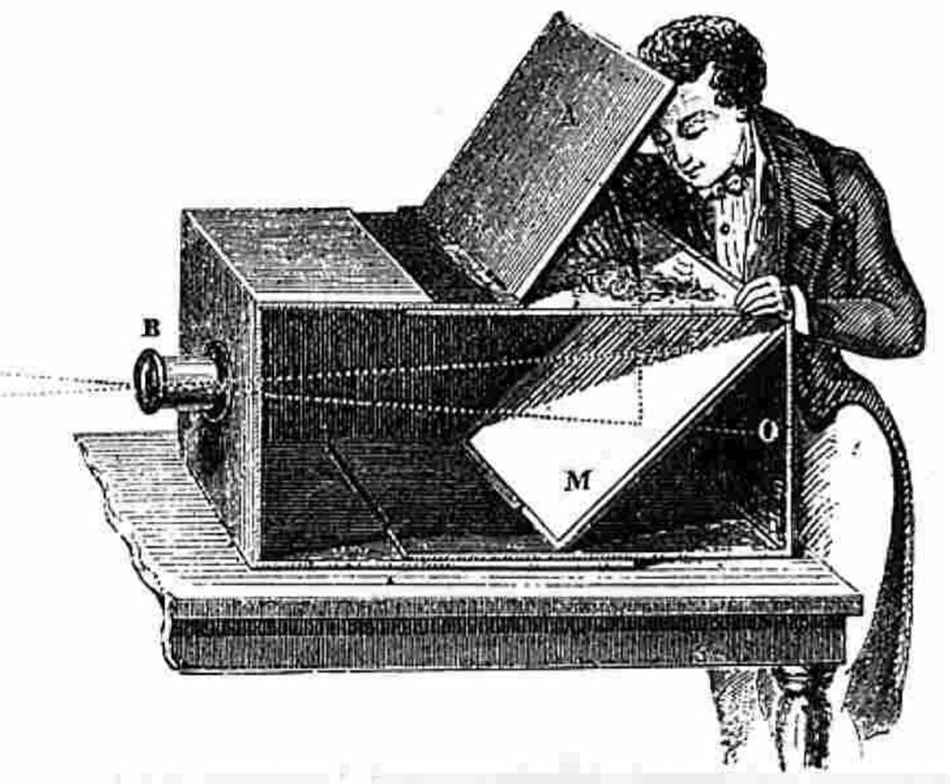
An artist uses a camera obscura to trace a projected image.
As low tech as that sounds, the principle of the camera obscura carries over even today in every camera in existence. Light enters a light-proof device (the camera) through an opening (lens, aperture) and manifests an image. The only things that have changed is the form of the light-proof devices and the manner by which the image is recorded.
Chapter 2: The dawn of the photograph
Fast forward about 2,200 years. It is around 1826 and we find ourselves back with Joseph Nicephore Niepce [2]. He is looking out his window and he is about to make a photograph… well, a heliograph, to be exact.
This is Joe.
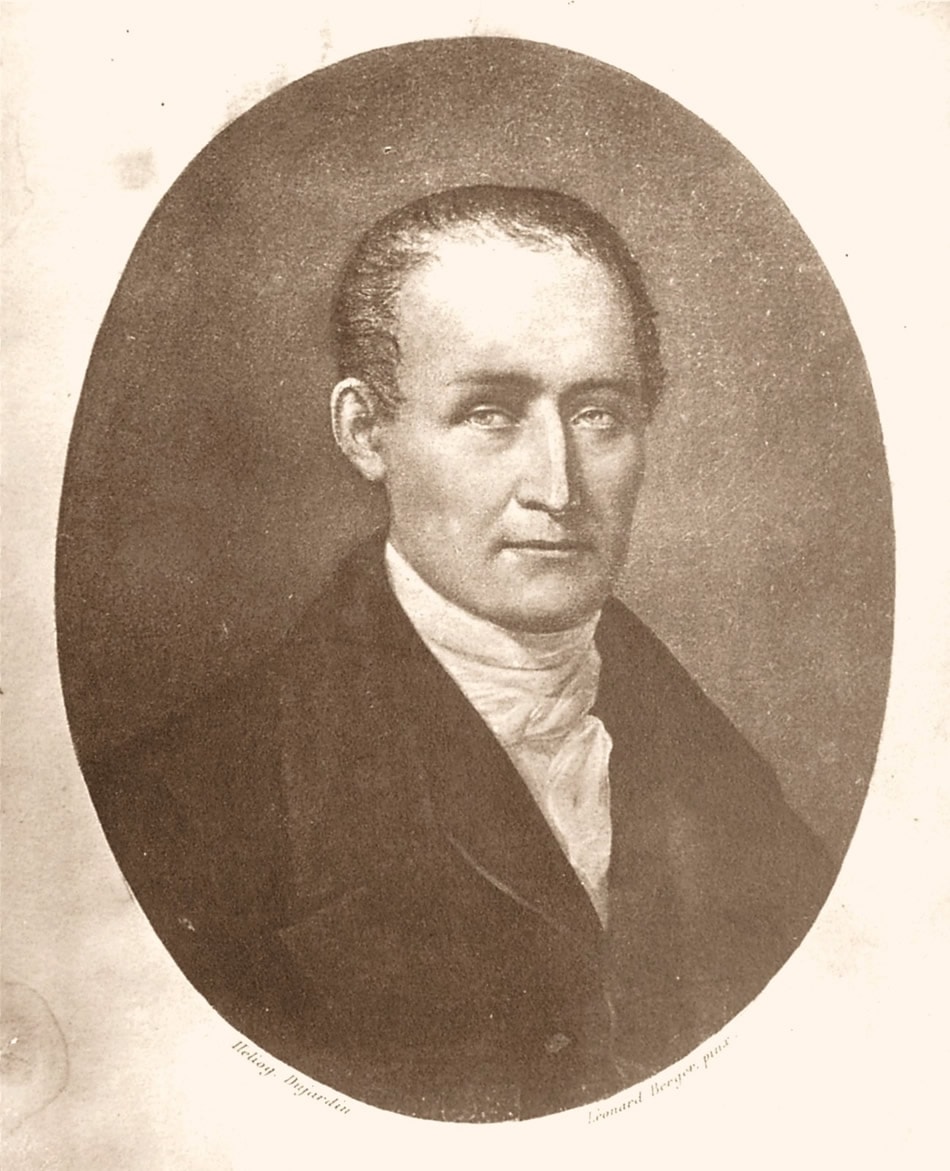
Joseph Nicephore Niepce, Wikimedia [3]
This was around the time Niepce produced what is believed to be the oldest surviving photograph from a window of his estate located in Le Gras in the Burgundy region of France. What Mr. Niepce concocted was a small piece of polished pewter which he then coated with a solution of bitumen and lavender oil. Bitumen is a naturally occurring asphalt and is sometimes referred to as Bitumen of Judea [4]. The most interesting property of bitumen is that it is light sensitive.
So, for what has been speculated from anywhere between eight hours to several days, the piece of polished pewter with bitumen emulsion remained in Joe’s camera obscura. What resulted was this:

Shortly thereafter, Niepce partnered with a Parisian artist named Louis Daguerre [5] and began further investigations and refinements into Niepce’s process. Sadly, Niepce passed away in 1833 but luckily left his notes entirely to Daguerre who continued working. Louis favored a silver-based processes and used plates with silver coatings which were exposed to iodine fumes. The iodine reacted with the silver and produced a coating of photosensitive silver iodide on the plates.
The major innovation of Daguerre’s process was the discovery that by applying mercury fumes to the exposed silver plate he could actually make the “latent” image visible on the plate thus reducing the lengthy exposure times of previous methods. Now, exposures could be measured in minutes instead of days. Daguerre’s method of silver iodide emulsed plates developed with mercury vapor was called… you guessed it… the Daguerreotype [6]. These instructions were then published as a free gift to the world on August 19th, 1839.
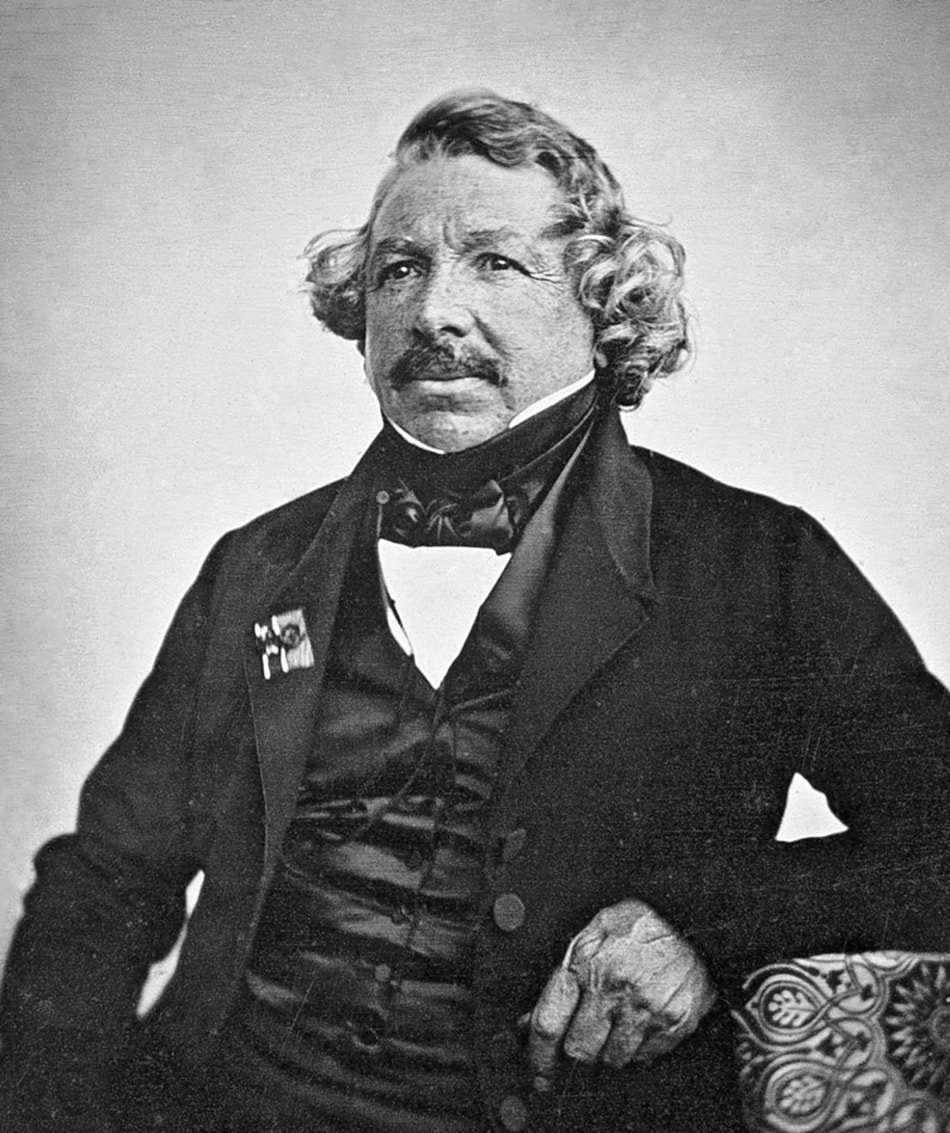
Mr. Daguerre
Now for a little controversy. A few days after Daguerre announced his invention of the Daguerreotype process and applied for Scottish and English patents another inventor stepped forward. The man claimed that he had devised a method for obtaining and fixing images made from light and had been experimenting since around 1834. The inventor was an Englishman named William Henry Fox Talbot [7]. As it turned out, Talbot and Daguerre used very different processes for their images but that did not exactly put the matter to rest. Talbot maintained that his Talbotype/calotype” process was in fact the genesis of the still infant art of photo making and sought remuneration for many years afterward. Some blame the prolonged contentions were a product of national animosities between France and England brought about by the memory of the Napoleonic War which was not yet thirty years past.
Now for even more controversy….
There was another who claimed the title of “First Photo Guy in History”. The inventor’s name was Hippolyte Bayard [8]. Not only did Mr. Bayard possess one of the most outstanding names in the history of namery but he also asserted that it was he, not Talbot nor Daguerre, who invented the photograph. Bayard claimed to have invented a printing process called the Direct Positive method and produced images on silver chloride paper. As direct positives, the images produced were developed and viewed on the same paper on which they were exposed. Hipp claimed that a friend (who also happened to be a mutual acquaintance of Daguerre) had convinced him to postpone announcing his process and thusly cost him the recognition he felt he deserved as being counted among founders of the photography. That’s not to say that Bayard faded from the histories of photo making. In fact, in his despondency over the event, Bayard produced what is considered to be the first staged/contrived/creepy photographs ever made titled “Self Portrait of a Drowned Man” in 1840…

Self Portrait of a Drowned Man, source [9].
He later went on to lead a successful career in photography and photographed many of the important points of architectural interest throughout France.
Chapter 3: Humans photographing humans
Thus far all the advances we’ve talked about were just images made of stationary objects or scenes. The next step in the evolution of photography involves the imaging of humans. Let’s briefly discuss how photo making would transform the way humans record themselves and their actions… but first… a selfie.

Robert Cornelius
This image is considered to be the first intentional portrait of a human being made… ever. The subject and photographer is Robert Cornelius, an American who worked in metal polishing and silver plating. Cornelius had became interested in the Daguerreotype process and sought to refine the technique using his knowledge of chemistry and metallurgical composition. In either October or November of 1839, Cornelius stood outside of his family’s store and made what would be the first selfie [10] in a line of billions to come. On the back of the photo he wrote “The first light picture ever taken.” Though not entirely accurate, Cornelius was correct in that his photo would go down in history as the first time a person was intentionally imaged using light.
Unknown to Cornelius, there had already been an image made that included human beings, although that was not the original intention. About two years earlier the evolution of photography had already taken one of its greatest leaps forward. In the Spring of 1838, Daguerre (remember him?) made a photograph of the bustling Boulevard du Temple in Paris. The long exposure time made everything that was moving literally vanish from the frame due to motion. It was only two people, a man having his boots shined and the shiner, who remained still long enough to be recorded in the photo. Those two people would never know that they were in fact the first humans to be photographed in history.

First humans to be photographed in history.
Chapter 4: If you print them… they will come
The next step in the evolution of photography finds us moving from the age of the Daguerreotype into the era of highly detailed and reproducible photographic imaging.
Up until that time, photographs were direct positives and unique and were not re-printable; meaning that the only way of making a copy of an existing print was to make a photograph of that actual print. If they were re-printable, such as the calotype, the detail and contrast was not very qualitative. All of that would soon change. The year is sometime around 1850 and Frederick Scott Archer [11], a sculptor by trade (earlier he worked as a silversmith), has been photographing his statues using the talbotype/calotype [12] process. He finds that the images produced with this method weren’t of sufficient quality for his needs. So what does one do when one finds oneself in one situation where there’s only one thing that one can do (that’s four if you’re counting)… anyone? Well, apparently one (that’s five) invents a completely new photographic process. The new method Fred invented was called the collodion process.
The process of collodion print making is essentially the use of some type of rigid material (most often glass) that was then washed in a collodion solution which had been mixed with silver bromide or silver iodide. The result was that the photosensitive silver compound was suspended within the collodion on the surface of the plate.
Perhaps one of the more readily identifiable flavors of the collodion process is that of the tintype. Two men, Hamilton Smith of America and William Kloen of Great Britain, patented the process at virtually the same time in the year of 1856. The tintype [13] became ubiquitous as the photographic process by which most images from the American Civil War and many of the “old timey” classical images we love from the Victorian era were made. The process employed a thin ferrous plate (iron… not actually tin) that had been lacquered black. The lacquered piece of iron was then treated with either a wet or dry emulsion of silver halide and collodion emulsion. The latter dry process became the much more favored method since it allowed plates to be prepared before they were needed to make a photograph.
Development was also quick and for the first times photographers were capable of producing images in a matter of minutes from start to finish. The prints were also much more durable than any other photographs which came before them allowing prints to be carried in coat pockets and ladies handbags. This no doubt gave rise to the very first cases of being trapped by parents wanting to show off images of their children to uninterested friends and relatives.

Billy “The Kid” in Tintype.
Chapter 5: A brave new brownie, Leica, and the birth of 35mm
Not even twenty years after the advent of the tintype, the next phase of photographic evolution occurs. Dr. Richard L. Maddox [14] improves the dry process of the tintype and introduces a method simply called “dry plate” or “gelatin dry plate.” The dry plates were small and commercially available. This was a monumental breakthrough in photographic development technology. Smaller cameras could now be used with this method; cameras which could be hand-held and use ready-made gelatin dry plates to make detailed images with short exposure times which were much more candid and personal. This was an absolute revolution in photography. The age of the “snapshot” had arrived.
The year: 1925. At the time, photography was still the domain of medium and large format cameras. The most popular portable camera of the era was the Kodak Box Brownie [15].

Kodak Box Brownie, Wikimedia [16]
The Brownie itself was fantastic advancement because it enabled users an affordable and convenient alternative to the large and bulky plate cameras. Though relatively small and in roll form, the film used in the Brownie still measured 5.6 inches square per frame. Enter Oskar Barnack [17] of Germany, an optical engineer and inventor. Oskar will introduce a game changer… well, two game changers. First, he is the inventor of the Leitz Camera… more famously known as the mighty Leica. The Leica [18] is still considered to be one of the finest camera systems in the world.
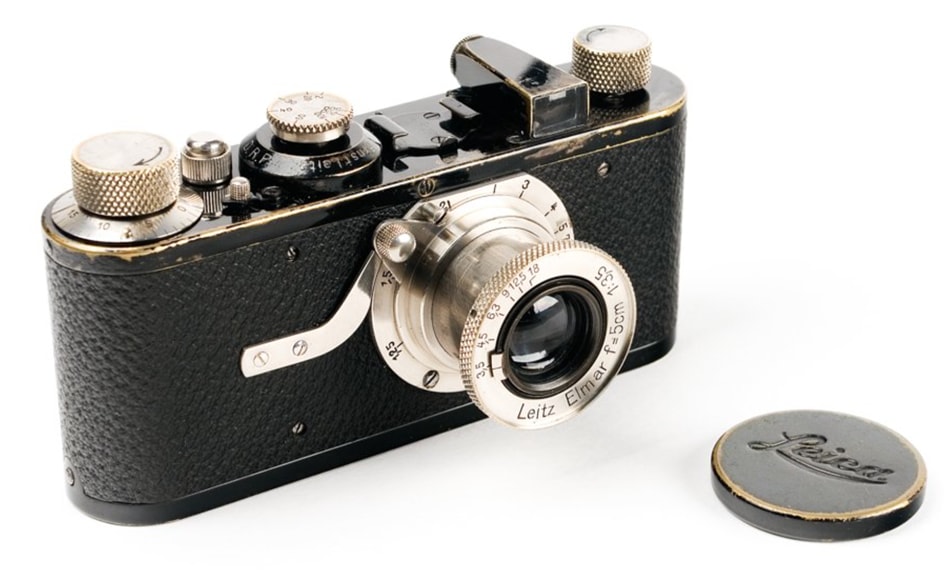
By Eugene Ilchenko (Own work), via Wikimedia Commons
The Leica was small and compact. The reason for the relatively small size of the Leica was due to the utilization of the George Eastman’s dry emulsion roll photographic film in 135 format (35mm). The 35mm film roll will come to dominate the photo industry for the next seventy-five years and will be used in point and shoot, rangefinders, and SLR cameras. Canisters of 35mm film will be the gold-standard for photographers from hobbyist to pro.
Chapter 6: Adventures in color
This brings us to the age of color photography. In order to talk about the evolution of color imaging we’ll have to do a little back tracking in order to fully understand its origins. In fact, making color photographs goes back in time a little further than you might have previously thought. The notion of color photography has been around since the 1850’s although we can be certain there was someone before that time looking at their monochrome photo and asking “Wouldn’t my suit look better in color?” The entire invention of the color photographic process is a long and extraordinary story involving advances in both in the anatomical understanding of how our eyes gather light and also how our brain interprets color.
The progression is rather, well, lengthy. It might even seem as if we are cheating the incredibly brilliant advent of such a leap in photographic technology by discussing it so briefly. The truth is, the evolution of color photography involved the moving of the medium from the highly technical environment of the laboratory and into the hands of the photographer.

There were many different processes invented over the course of the following decades between 1850 and 1900. The Scottish physicist James Clerk Maxwell produced a paper on optical color vision [19] and perception in 1855.
The paper proposed that we interpret color through a multitude of cone shaped cells located on the surface of the rear aspect of our eyes. Maxwell [20] asserted that different areas on each of these cells are sensitive to red, blue, and green light spectrums and it was these combinations of colors which were responsible for our interpretation of the colors around us. This idea, called the “three color process” or “RGB” is the foundation of virtually all color photography methodology we have with us today. Now that the anatomical science of how we see color was becoming better understood, it was time for the evolution of color photography to begin. The first known photograph produced using the concepts set forth by J.C. Maxwell was taken in 1861 by Thomas Sutton [21], an English photographer and inventor. The photo was made by stacking three black and white images [22] which were themselves each exposed using red, green, and blue filters. The image could then be viewed in color as a superimposition from three separate projectors which each used a corresponding green, red, or blue filter. Yeah, it was just that simple….
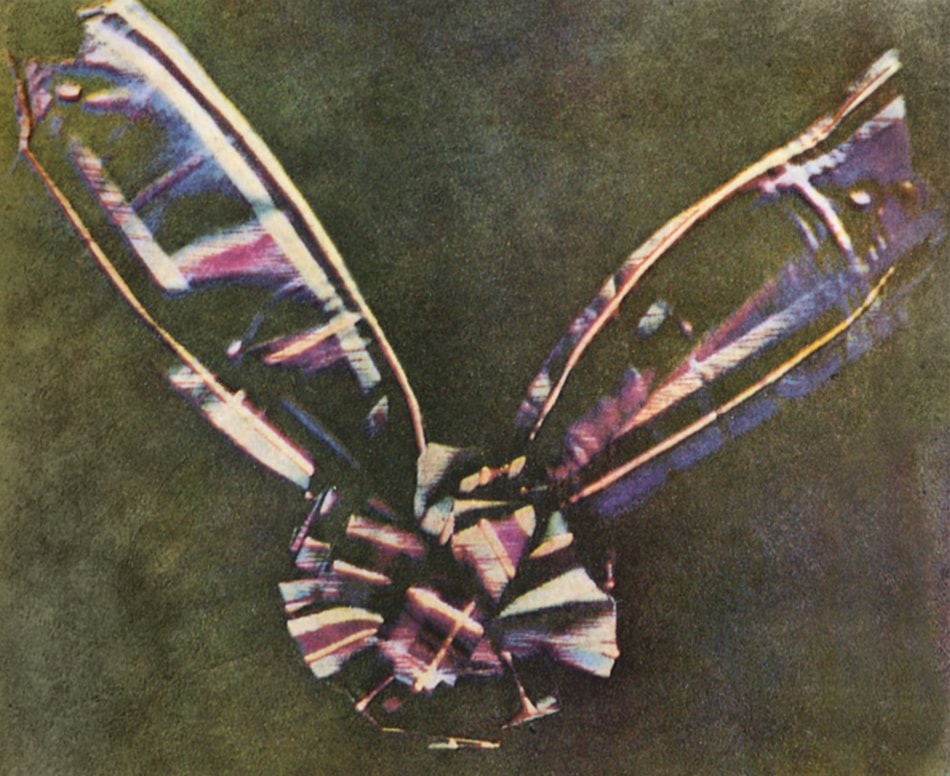
The first known color photograph ever made.
This sets photography onto the path of colorization… and of course, it will not be an easy nor uncontested road.
Chapter 7: Mr. Land, I presume?
The majority of the problems encountered with the initial colorization methods stemmed not from the production of the color prints themselves but rather with the permanence of those images after they were developed. Color photographs, when they could be produced, were very sensitive to ambient viewing light and would disappear or greatly degrade in quality when exposed to natural light. This problem was solved around 1891 when physicist Gabriel Lippmann developed a process based on the interference phenomenon of light wave propagation which won him the Nobel Prize for Physics in 1908 [23]. Using this process, color photographs could be produced and viewed in normal light without the dreaded print fading faced by earlier endeavors into color.
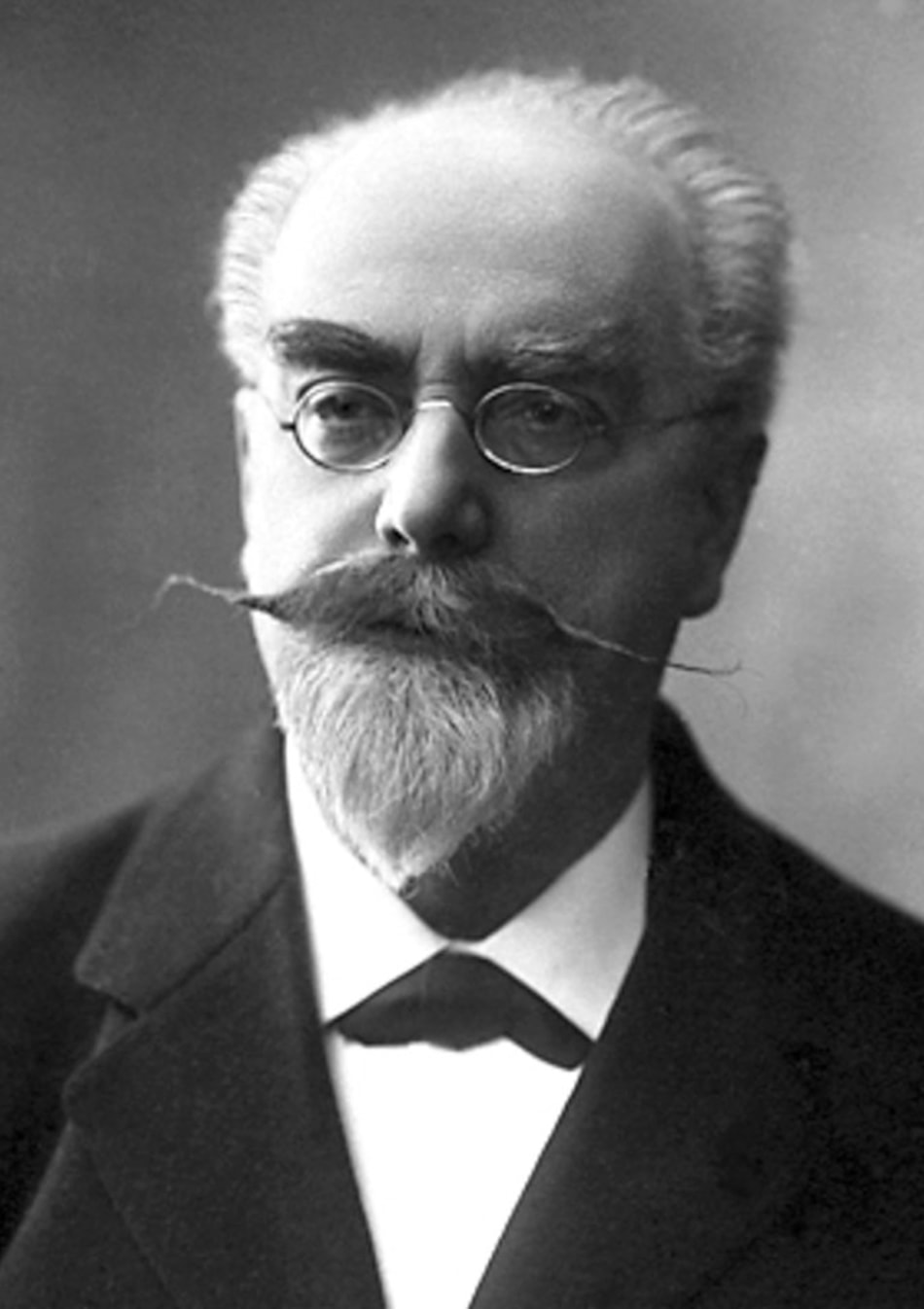
Gabriel Lippmann
Skip ahead some six decades to 1950. Many advances have been made and color photography is becoming the most sought after and now readily available photographic mediums. People love seeing the world in living color and most importantly themselves. This is a time when a man who you might not have heard of comes onto the scene and questions the very principles on which color photography had been built. The man’s name is Edwin Land [24]… if that that doesn’t ring a bell, you will no doubt know him by the company he co-founded: Polaroid [25].
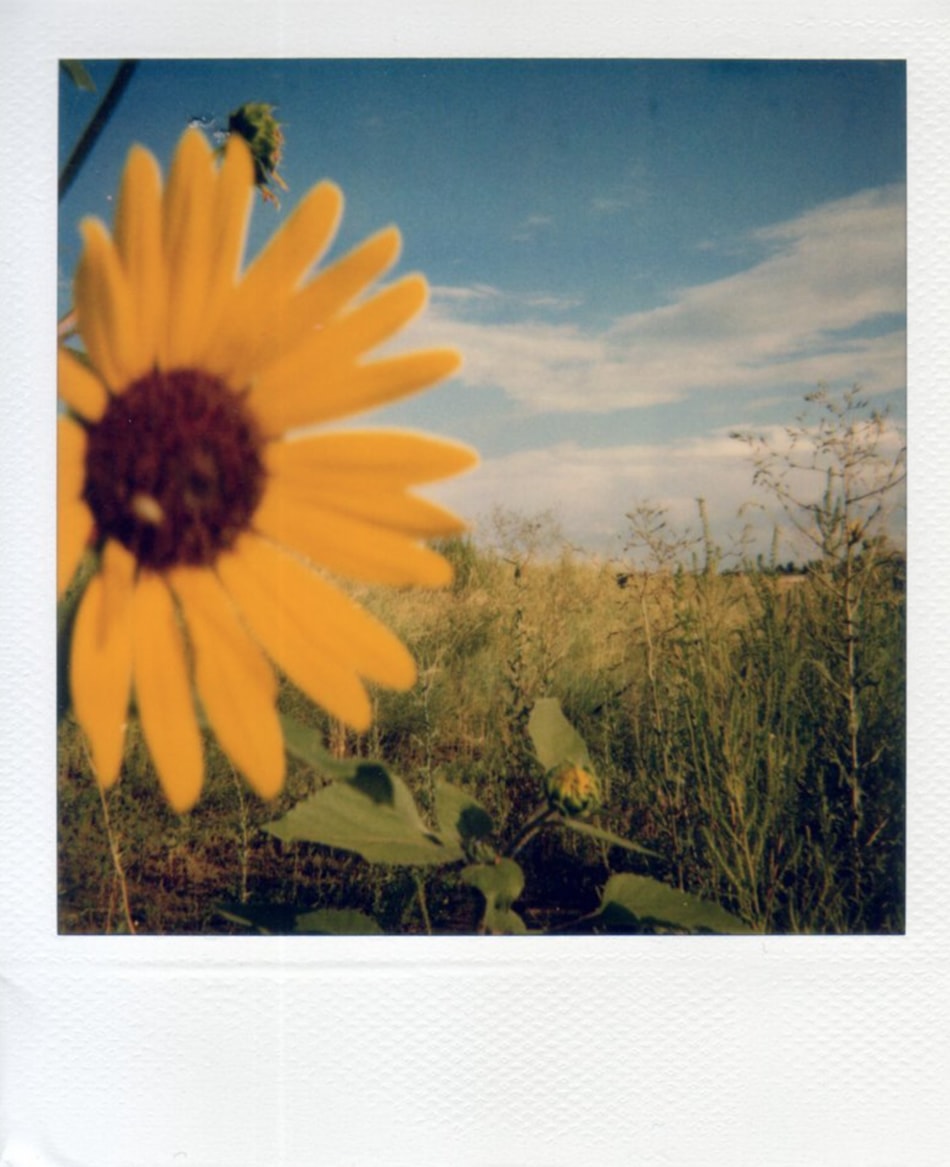
By Mrnerd1billion Ryan Notch [26] (Own work), via Wikimedia Commons
Land believed that the entire idea of RGB and the three color process was not wholly accurate. Instead, he based his methods on a “two-color process” which stated that each cone cell within the eye did not have differentiated nerve endings which perceive red, blue, or green independently. Land’s proposition was that each cone cell sensed frequencies of only red and green light as it passed through the microscopic capillary structures inside of the eye itself. Granted, that description is the most basic and simplified version of the two-color process that I can muster (you can thank me later). Though Land’s two-color process will become the basis for Polaroid’s enormous success in the coming decades, it was not as widely accepted as the three-color process proposed by Maxwell.
Chapter 8: the rise of digital
Digital. Yes, let’s finally talk about the world of digital photography. We will forgo the earlier advent of digital imaging as it relates to digital copying, analog-electronic cameras, and most prototypes. We will push forward and cut straight to the heart of more recent true digital photography.

Let’s begin with what makes digital photography different. Instead of film, digital cameras use a charged-coupled device or “CCD” to convert light to an electronic file such as a JPEG or MPEG. The CCD has a layer composed of a photosensitive capacitor array which senses light of different intensities therefore transferring the relative data to the camera’s processor. The charge-coupled device was invented in 1969 at AT&T Bell Labs by Willard Boyle and George E. Smith [27].

© Prolineserver 2010 / Wikipedia/Wikimedia Commons, via Wikimedia Commons.
It is commonly believed that the first ever commercially manufactured portable digital camera was the Fuji DS-1P [28] but it was never released for sale to the public. It was produced in 1988 and stored it’s images on a 2MB SRAM memory card. Three years later in 1991 Kodak upped the game and introduced the Kodak DCS [29] which sported a “massive” 1.3 megapixel image sensor and sold for a cool $13,000 USD. Not to be outdone, Minolta ushered in the DSLR age in 1995 when they released to first ever portable digital SLR camera. The Minolta RD-175 [30] offering gave photographers the luxury of using a 1.75 megapixel sensor and was based on the Minolta 500si [31] camera body.

By Jamo spingal (Own work), via Wikimedia Commons
This lateral crossover also allowed the use of native Minolta AF mount lenses. This same “old to new” concept was used four years later when Nikon developed the first DSLR which was not based on a previous SLR model. The Nikon D-1 [32] let photographers use the same lenses from their film cameras on their new DSLR which hefted a 2.74 megapixel sensor all for the modest price of around $6,000. Let that sink in for a minute….
Behold….
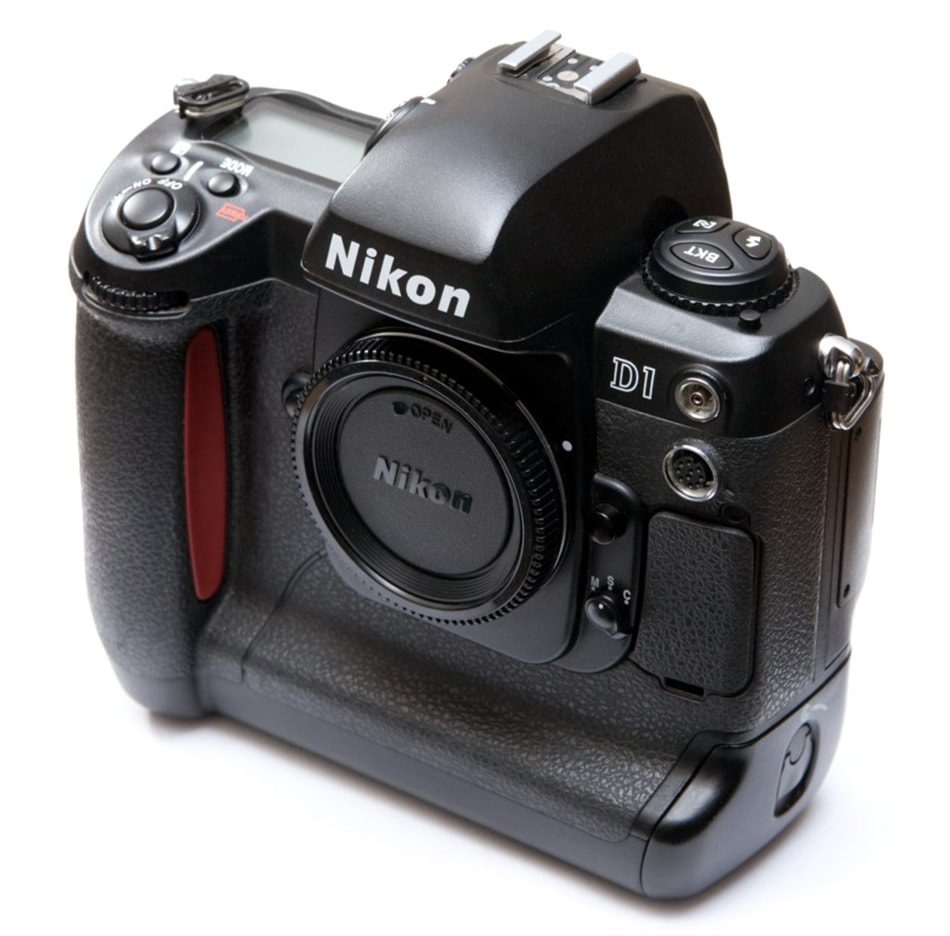
By Ashley Pomeroy (Own work), via Wikimedia Commons
Chapter 9: A brave new world
Give the digital camera revolution about ten or fifteen years to stew and now we find ourselves landed here in the present. We trudge knee-deep through swamps of the newest cameras and lenses and any other piece of gear we can dream into reality. Imagine the reaction of Niepce if he saw the ease by which photographs are now taken instantly on the street. No more bulky camera obscuras. Without plates or film or chemicals. Just press the button.
Does this ease of production outway the quality of production? Without a doubt, the majority of those 800+ trillion photos we made last year will not be pieces of treasured art or make their way onto the walls of the finest cafe in Paris. At the same time, however, they do fulfill the most basic and primordial purpose of photography. Those pictures preserve a memory. It might not be a far reaching preservation, but it is preservation nonetheless. This fixing of memory has the potential to give us a measure of happiness within ourselves that is no less satisfying than that felt by the first picture takers over two centuries ago. The difference between us and them, is that we have perhaps become numbed by the very magic they helped to create.
The next evolutionary phase of photography might not be a progression in the way we make images. Instead, it’s quite possible the next unseen horizon will come from the way we share those images with the world or how we store them for ourselves. If a photograph indeed captures a memory, what use is that memory unless it can more tangibly recalled. Looking back in the history of photography has each subsequent advancement not strived to make the photo more qualitative, more lasting, and more real?

The Fifties in 3D, by The National Archives UK. Wikimedia Commons [33].
Chapter 10: Shepherds
From the heliograph [34] to the Daguerreotype and collodion process and from there onto film and then at last to digital. Each new birth of image capturing technology was coupled (or even surpassed) by the method and medium used to preserve and display those images. With our ever advancing display and projection devices, could the next quantum leap be a jump into the realm of unprecedented photographic realism? Though the future is most definitely unknown, it is very possible that the biggest step forward for our art could come from the way we view our images instead of the way me make them.
This begs the question: are we nearing the end of our evolution in the genus photographic?
Questions as far reaching as this can only be whispered and quietly contemplated. Any more than a whisper is likely to bring about less than civil debate and leave us with no answers. However, that should not force us to accept that we must “wait and see.” We should actively inquire about the future of our craft and in order to do that we must learn as much about photography as we possibly can. In that way, through knowledge, we are able to play a hand in our own evolution as artists. We might not be able to control or even steer the course of photo making but perhaps it can be aimed. We can aim ourselves to take a more active role. Learn the past of your craft and how it has progressed. By understanding these things we empower ourselves to move beyond being merely passengers on the journey that is photography.
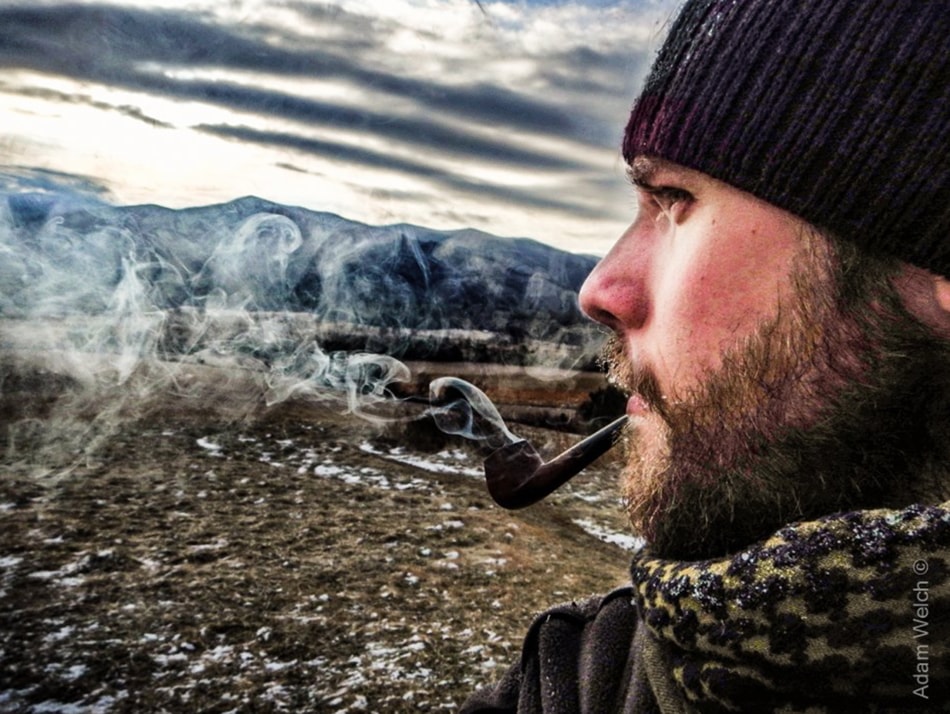
The greatest contribution that you, yes… you can make in order to ensure the continued evolution of photo making is to pass on your knowledge. Tell others about what you have gained from your own experiences; be it technical know-how, creativeness, or just talking about how your heart swelled as you watched the morning sunlight slowly crawl over that mountain top. The willingness to share anything and everything virtually guarantees that our art will continue. The next great thinkers and innovators are out there right now. Some of them might be on the verge of giving up just because they don’t understand aperture or can’t figure out how to bracket an exposure. Take the time to mentor those who want to learn and most importantly, remember that we are only the caretakers of our art and not the creators. We as photographers are the benefactors of nearly 200 years of photographic knowledge which was generously paid forward. Where photography goes from here is up to us. We Abide. We are the shepherds.
A word from the author
This article is should not be and was not intended to be a history lesson. Instead, I hope it is received in the spirit in which it was written. It is the hope of the author that the information found here will give you a better understanding of the origins of photography, it’s progression as an art form, and to inspire forward thinking as to it’s future.